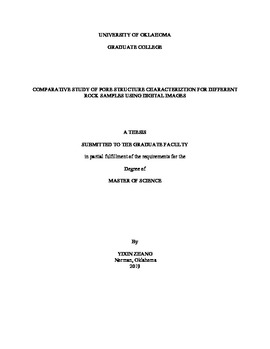| dc.description.abstract | Due to the scarcity in supply of energy and slumping production from conventional reservoirs, exportation from unconventional tight shale reservoirs has received considerable scholarly attention in recent years. However, the evaluation of a variety of heterogenous unconventional reservoirs is challenging, because there are some imperfections and uncertainties associated with the understanding of the microstructure in tight shale reservoir. Thus, the aim of this thesis is to examine a novel approach to analyze the pore structure characterization of the Marcellus and Eagle Ford shale samples.
In this study, we utilize Scanning Electron Microscopy (SEM) and micro-CT images of four different lithological rock samples including shale, sandstone, carbonate, and limestone to assess complex pore structure characterization, pore connectivity, and simulate single-phase flow. Meantime, the shale rocks are compared with 20 distinct lithological rock samples to evaluate differences between their pore structure properties. We establish a three-dimensional pore structure model for each sample and partition pore space to extract the corresponding pore network model using the hybrid algorithm. Additionally, we predict the absolute permeability through intrusion percolation simulation. Based on the image processing software in this study, the specific pore space parameters including porosity, pore radius, tortuosity, coordination number, are obtained. Results indicate that the computed petrophysical parameters and transport properties of shale samples are much smaller than those of carbonate, limestone, and sandstone. Furthermore, the results suggest that for the studied shale sample, Representative Elementary Volume (REV) is around 5 μm, which is smaller than that of carbonate, limestone, and sandstone samples. The results from this study will provide a new insight into a complex pore structure and achieve the visualization of a micro-pore structure. | en_US |
